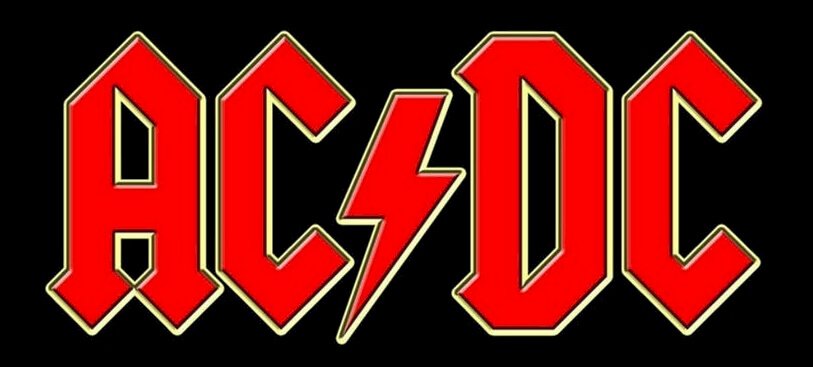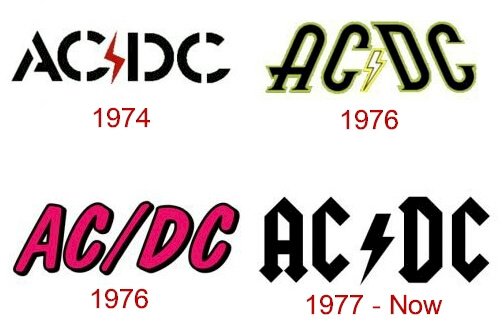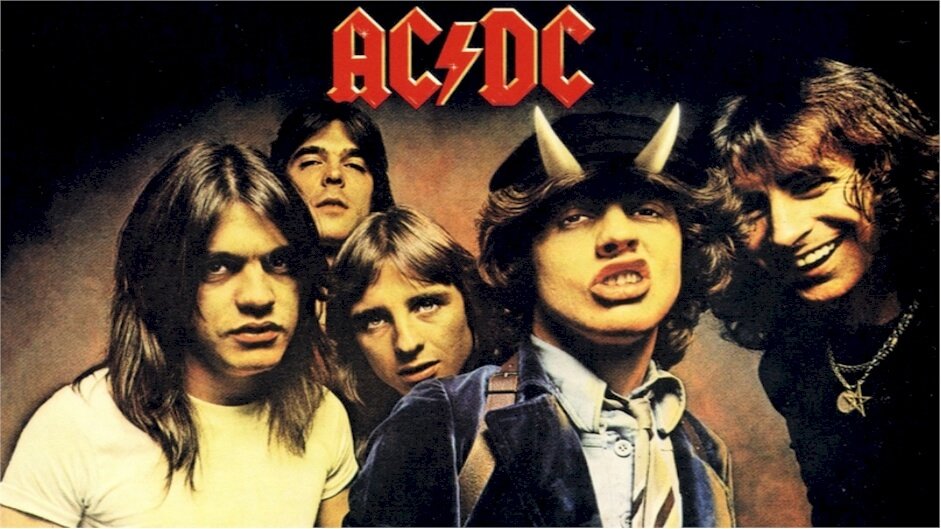The AC/DC band boasts one of the most adored and most memorable logos ever created. It resulted from the successful partnership between Gerard Huerta—a renowned graphic designer—and Bob Defrin—Atlantic Records creative director.
The ACDC logo was introduced in June 1977 when the band released the international version of its fourth studio album dubbed “Let There Be Rock.”
What Does the AC/DC Logo Stand for?
The iconic ACDC logo is widely recognizable, partly because the name makes up the logo. Graphic designer Gerard Huerta created it in collaboration with Atlantic Records art director Bob Defrin.
Huerta chose the font lettering, which he had seen in the Gutenberg Bible. The AC/DC brothers decided this name after seeing the “AC/DC” inscription on their sister’s sewing machine. This is short for Alternating Current, Direct Current. The logo has now gone on to become a rich part of pop culture and has even transcended the band and its sound.
Who Designed the AC/DC Logo?

Introduced in the summer of 1977, the current ACDC logo was designed by Bob Defrin, the art director at Atlantic Records, with the help of renowned graphic designer Gerard Huerta. The logo features the lightning bolt that had been removed from the previous version and sharp, carefully crafted Gothic lettering picked by Huerta.
The logo has been firmly integrated into the rock band’s image and concept, having been around for more than 40 years now. The blunt, bland, and white combination creates an electrifying mix of enthusiasm, courage, energy, and perfection.
AC/DC Logo History
AC/DC’s logo history includes four logo versions created between 1974 and 1977. Three major redesigns finally led to the current logo, which has remained the same since 1977. The band’s iconic symbol, which features a lightning flash between the two parts of the name, was adopted in 1974 and was inspired by their debut album “High Voltage.” It has been on all of their emblems except for the 1976 version, which featured a slash sign in place of the bolt.
1974 – 1976
The band’s first ACDC logo was designed in 1974 and featured the band’s name written in an extra-bold sans-serif stencil font, with the black letters separating a sharp, red lightning bolt. The letters and the symbol were squeezed closely, but the full logo still looked fresh and balanced thanks to the wide stencils.
1976
The 1976 redesign of the logo changed the color palette to black and yellow. The designers also opted for a smooth serif typeface to replace the original san-serif stencil. The “AC” part was now made to incline to the right, while the “DC” part leaned to the left. The lightning bolt was changed to white, with a double black and yellow outline, which balanced the arched letters’ outline.
1976 – 1977
This was the only version of the band’s logo without the lightning bolt and was created for their third album, “Dirty Deeds Done Dirt Cheap.” The letters were changed to a bright pink and black in a handwritten sans-serif typeface with smooth, rounded letters and a thick black outline to evoke a sense of energy and motion.
1977
The Iconic ACDC band’s logo we see today was released in 1977. The stylish geometric typeface with angled letters and rhombuses at the end of the “A” had a slightly enlarged lightning bolt between the two parts of the logotype. The monochromatic palette makes it easy to place the logo on various backgrounds, retaining its robust character.
AC/DC Logo Design Elements

Shape and Font: The AC/DC font utilizes a Gothic typeface which was derived from the Gutenberg Bible. Huerta was inspired by the band’s fourth studio album titled “Let There Be Rock” in picking the lettering to complement its biblical mood.
This version of the logo font turned out to be a massive success and is still very popular and adored today, having appeared on more than 20 million album covers, tour posters, and other band merchandise.
Colors of the AC/DC Logo: The white color in the AC/DC logo represents energy, passion, and excitement, while the black convey the excellence of the band’s music.
History of the AC/DC Band
Brothers Malcolm and Angus Young were the founders of the band, although Angus attributed the band’s formation to his brother. In 2014, Malcolm announced that he would be retiring from the band due to dementia, and he later passed on in 2017.
The AC/DC Band Formation
The Young family immigrated to Australia from Scotland in 1963 during a cold winter, reportedly through an assisted immigration scheme. Because the dad was continuously unemployed, the family had lived in poverty for many years. That winter was the worst in recorded history, and with temperatures falling below zero, the family could not resist the discounted one-way tickets out of the country.
At the time, the Young family was large, with seven children and two parents, and they had to do with living in a makeshift tin hostel. George formed a band that he branded “Easybeats” and practiced in the laundry room.
Within two years, their hard work had paid off when the band landed a recording deal. It then released “Friday on My Mind,” which became Australia’s first international hit. The band then moved to the UK in 1966 thanks to its global success, but the success didn’t last long. Easybeats finally split up in 1969, and as if things couldn’t be worse, the band was heavily indebted.
While George was reeling from his band’s failure, his brothers were still in school but not doing well. Malcolm had been enrolled at Glasgow school and was constantly embroiled in fights. Angus joined the school, but Malcolm’s precedence was, unfortunately, not in his favor.
Angus was caned on his first day at school to warn him against fighting. Seeing that the family did not boast a good reputation, Angus was finally given an ultimatum to either leave or get expelled from school.
However, all that turned out to work in their favor because when George moved back to Australia in 1973, he asked both his brothers to form a new band with him. At the time, their sister Margaret had a sewing machine with an “AC/DC” inscription meaning alternating current/direct current. They took up these initials for their band’s name, and that was the birth of AC/DC, the band.
AC/DC Becomes a Renowned Band

In late 1973, the band came to be, and they brought on other people in different capacities; among them was the lead vocalist, Dave Evans. Unfortunately, Dave lasted less than a year because the brothers felt his voice did not match up with their rock sound. Their band manager agreed and brought Bon Scott in 1974 to replace him.
The band then toured the country and relocated to Melbourne, and with the help of George and his writing partner Harry Vanda, it released an album every year. Their record-breaking album, High Voltage, was released within a span of ten days in October 1974.
By then, the band had stabilized, each member taking on a specific role. Malcolm and Angus were the band’s guitarists, Scott was the lead vocalist, Michael Rudd played the drums, and Mark Evans was on the bass. Their debut gig was in August 1974, where they met promoter Michael Browning, who took a chance on them.
AC/DC Breaks Through
The first big break in the band’s career came in its collaboration with Mutt Lange, who produced its sixth studio album “Highway to Hell” in 1979. Eddie Van Halen remembers this as his favorite AC/DC record alongside Powerage.
The record became the band’s first to break into the US top 100 charts, peaking at No. 17, and catapulted the band into the top ranks of hard rock acts. The album had lyrics that leaned toward more central rock themes, which was a shift from their more flippant, comical style.
In 1980, the band started working on its seventh album “Back in Black” before being struck by tragedy. In February 1980, Scott passed out in the car on the way back from a friend’s house after a night of alleged drinking and drug-taking. According to the friend, Scott had been unable to move upon arrival at his place, so he had to leave him in the car overnight.
AC/DC Lineup Changes and Commercial Decline (1983–1989)
The band broke up with producer Mutt Lange for its ninth album, “Flick of the Switch,” which came out in 1983. The album was, however, largely considered a failure and described by critics as underdeveloped. One of the critics remarked that they had made “the same album nine times.” Later on, in a readers’ poll, the band was voted the eighth-biggest disappointment of the year.
AC/DC Regains Popularity (1990–1998)
The band recorded its twelfth studio album, “Razors’ Edge,” in Vancouver, BC. The record was produced and mixed by Mike Fraser and produced by Bruce Fairbairn.
The album was released in 1990 and was a great success for the band, with hits including “Are you Ready” and “Thunderstruck,” which reached No. 16 and No. 5 respectively on the Billboard’s Rock Chart, as well as “Moneytalks,” which reached No. 23 on the Billboard Hot 100.
The album was certified multi-platinum and reached the US top 10.
AC/DC Popularity Confirmed (1999–2013)
AC/DC recorded its 14th studio album, “Stiff Upper Lip,” which was produced by their brother George Young in Vancouver. The album had a better reception with critics after its release in February 2000, although it was considered as lacking fresh ideas.
The album’s Australian release included a bonus disc with a few promotional videos and several live performance recordings done in Madrid in 1996. The album reached No. 1 in five countries, including Germany and Australia. The leading single, “Stiff Upper Lip,” stayed at No. 1 on the US rock charts for four weeks. The band also performed the same song on SNL in March 2000.
In 2002, the band signed a multi-album long-term deal with Sony Music, which later released several of its re-mastered albums. Each release had an expanded booklet with rare photos, notes, and memorabilia.
In 2003, its entire back catalog, except for the last two albums, was re-mastered and released anew. Ballbreaker and Stiff Upper Lip were to be later released in 2004. The band was thrilled to be inducted into the Rock & Roll Hall of Fame in 2003.
AC/DC Reunion and Power Up (2018–present)
In September 2020, the band updated its social media accounts with a video clip showing a neon light shaped in the form of its lightning bolt symbol. This sparked rumors that the band was preparing a comeback within the next two weeks. On the next day, the band’s website redirected to a new address and was updated with an online shop and an email sign-up form. The band then released another teaser video, further fuelling speculation of a reunion.
In late September 2020, AC/DC finally confirmed the return of former members Brian Johnson, Cliff Williams, and Phil Rudd, alongside brothers Angus and Stevie Young to complete the band’s reunion. On October 1, it released a snippet of its new song, “Shot in the Dark,” which got fans really excited.
Final Thoughts on the History of AC/DC
 AC/DC is one of the most successful bands in history, having sold more than 200 million records worldwide and ranked 5th in U.S. sales, ahead of Mariah Carey and Madonna. The ACDC logo has remained the same since 1977, but it’s only become more and more iconic and recognizable over the years. The band even had a street in Leganes, Spain, named in its honor.
AC/DC is one of the most successful bands in history, having sold more than 200 million records worldwide and ranked 5th in U.S. sales, ahead of Mariah Carey and Madonna. The ACDC logo has remained the same since 1977, but it’s only become more and more iconic and recognizable over the years. The band even had a street in Leganes, Spain, named in its honor.
Although the band has enjoyed massive success, it has also received quite a bit of criticism, with its songs seen by some as simplistic, deliberately lowbrow, and misogynistic. However, this has not stopped its fans from defending the band’s music as “bawdy humor,” while the band members have generally been dismissive of such claims.
All in all, AC/DC remains a popular band worldwide, and with its recent reunion, fans cannot wait to see what’s up next.







